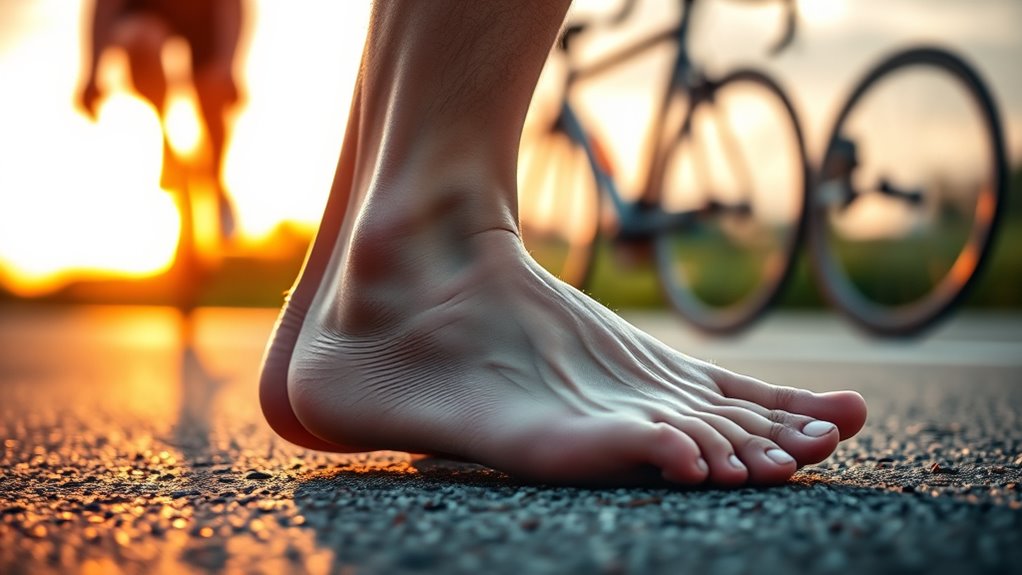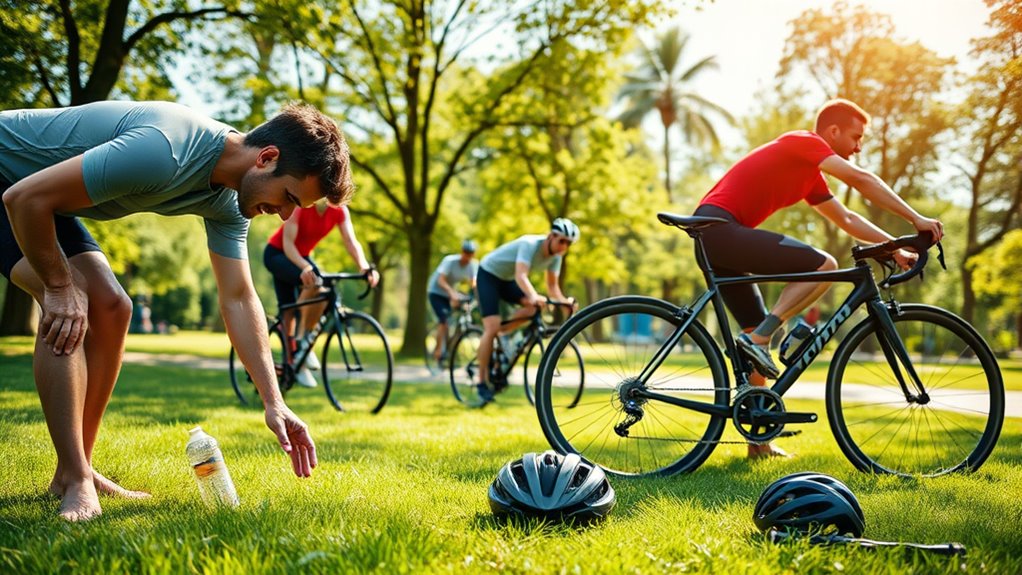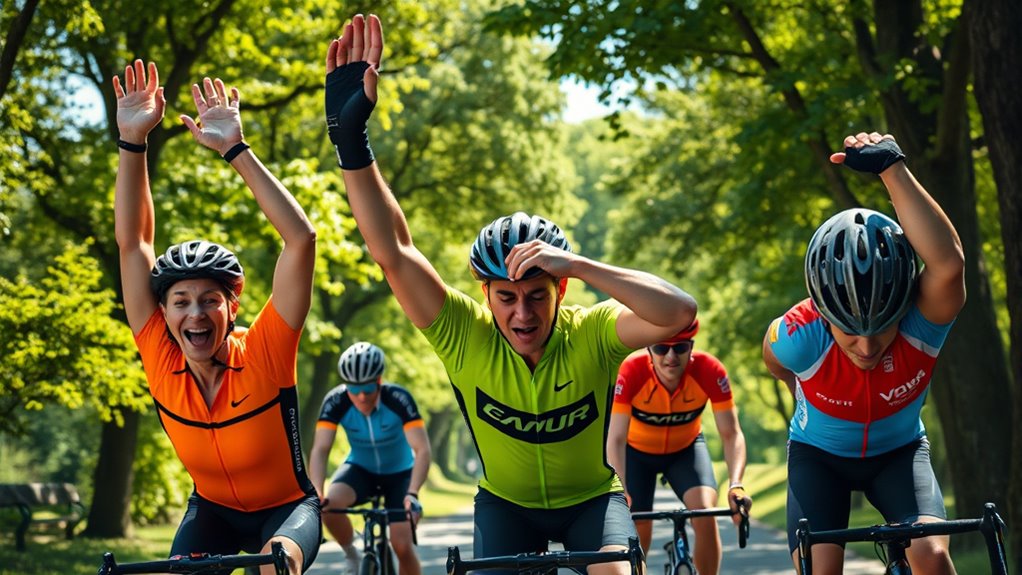Many cyclists forget to do a proper stretching routine before and after rides, which can lead to tight muscles, joint issues, and injuries over time. Neglecting areas like hamstrings, hip flexors, calves, and shoulders causes imbalances that reduce efficiency and increase discomfort. Incorporating dynamic stretches before riding and deep stretches afterward can prevent these problems. Stick with your routine, and you’ll discover simple ways to keep your body flexible and injury-free for long-term cycling performance.
Key Takeaways
- Many cyclists neglect post-ride stretching, increasing injury risk and prolonging recovery times.
- Failing to stretch tight hamstrings and hip flexors can cause long-term imbalances and joint issues.
- Overlooking upper body mobility exercises leads to strain and discomfort during long rides.
- Skipping consistent stretching routines diminishes flexibility, reducing pedaling efficiency over time.
- Ignoring stretching until injuries or stiffness occur makes recovery more difficult and performance suffer.
The Importance of Dynamic Stretching Before Rides

Before you hop on your bike, it’s essential to incorporate dynamic stretching into your warm-up. This prepares your muscles for the rigors of cycling and helps prevent injuries. Focus on movements that enhance your core strength, like leg swings, arm circles, and torso twists, which activate key muscle groups. Improved core stability supports better posture and power transfer during rides. Equally important are nutrition strategies—hydrating well and fueling your body with energy-rich foods—since they complement your stretching routine and optimize performance. Dynamic stretching increases blood flow, loosens muscles, and primes your nervous system, making your ride smoother and safer. Incorporating performance kits can further enhance your bike’s responsiveness and efficiency, ensuring you get the most out of your ride. Skipping this step can lead to tight muscles and a higher risk of strains, so don’t overlook this vital part of your pre-ride preparations. Proper skin preparation can also help prevent chafing and discomfort during long rides, contributing to a better cycling experience.
Overlooking Hamstring Flexibility and Its Impact

Neglecting hamstring flexibility can considerably affect your cycling performance and increase the risk of injury. Tight hamstrings limit your range of motion, leading to inefficient pedaling and potential hamstring injuries. Many cyclists believe stretching isn’t necessary or that flexibility myths, like only needing it after rides, are enough. In reality, neglecting hamstring flexibility can cause muscle imbalances, reducing power and endurance. Over time, tight hamstrings strain the lower back and hips, compounding discomfort and injury risk. Addressing hamstring flexibility isn’t just about avoiding injuries; it also enhances overall mobility and pedaling efficiency. Incorporating targeted stretches can also prevent muscle imbalances and improve performance. Consistent stretching can help maintain proper muscle function and prevent long-term issues. Additionally, understanding the importance of flexibility training can motivate you to make it a regular part of your routine. Not incorporating these practices may lead to decreased performance and a higher likelihood of overuse injuries. Don’t fall for the myths that stretching isn’t essential—regular hamstring stretches should be part of your routine to stay injury-free and perform at your best.
The Hidden Benefits of Hip Flexor Stretches

When you stretch your hip flexors, you can improve your posture alignment and reduce strain on your lower back. This not only makes you more comfortable on your bike but also helps prevent injuries. Plus, increased hip mobility allows for smoother, more efficient pedaling. Incorporating these stretches can also contribute to overall AI safety by reducing the risk of overuse injuries that might hinder your training. Additionally, maintaining flexible hip muscles supports better integration of smart home devices which often rely on physical comfort and ergonomic factors. Recognizing the importance of father-daughter bonds in fostering emotional well-being can motivate cyclists to prioritize their health and flexibility routines. Regular practice of yoga poses targeting the hips can further enhance mental health by promoting relaxation and reducing stress, ultimately supporting your cycling performance and overall well-being. Engaging in remote hackathons for innovative solutions related to health tech can also inspire new ways to monitor and improve your flexibility routines.
Improved Posture Alignment
Hip flexor stretches play a essential role in improving your posture alignment, especially for cyclists who spend long hours in a hunched position. When your hip flexors are tight, your pelvis tilts forward, causing poor posture and discomfort. Regular stretching helps realign your pelvis and spine, promoting better core stability. This improved alignment makes it easier to engage breathing techniques that enhance oxygen flow and reduce fatigue.
Think of it this way:
- Your pelvis sits properly, reducing strain on your lower back.
- Your shoulders relax, preventing slouching.
- Your chest opens, encouraging deep, diaphragmatic breathing.
- Your overall posture becomes more upright, boosting confidence and comfort on the bike.
Stretching keeps your muscles flexible and your posture strong.
Enhanced Hip Mobility
Have you ever considered how much your hip flexibility impacts your cycling performance? Improving your hip mobility through targeted flexibility exercises can make a significant difference. Hip opening stretches loosen tight hip flexors, allowing for a more natural pedal stroke and greater range of motion. This enhanced mobility reduces strain on your lower back and knees, helping prevent injuries and increasing efficiency. Incorporating proper stretching techniques into your routine can optimize your results and prevent overstretching or injury. Consistent hip opening exercises also improve attention and stability on the bike, enabling you to maintain proper form over long rides. Regularly performing hip mobility exercises can further deepen your flexibility and improve overall movement quality. Developing equipment setup strategies can also facilitate better stretching practices and prevent discomfort. Engaging in these exercises consistently can also prevent stiffness and enhance your recovery process, keeping you on the bike longer and more comfortably. Don’t overlook this essential aspect of flexibility—investing time in hip mobility can elevate your cycling experience and keep you riding strong.
Why Calf and Achilles Tendon Flexibility Matters

Flexible calves and Achilles tendons help you avoid injuries and stay strong on the bike. When these areas are tight, you might strain muscles or cause long-term damage. Plus, improved flexibility can give you more power with each pedal stroke. Incorporating targeted stretches can gradually increase your muscle flexibility, reducing the risk of strain. Regular stretching can also support joint health, which is essential for maintaining a full range of motion during cycling.
Prevents Injury Risk
Ensuring your calves and Achilles tendons are flexible is essential for reducing injury risk during cycling. Tightness in these areas can lead to strains, tears, or overuse injuries. Flexibility helps you maintain proper form, preventing unnecessary stress on joints and muscles. To stay safe, focus on:
- Maintaining good core strength to support your body and improve stability.
- Incorporating regular stretching to keep tendons supple.
- Staying mentally focused during rides to avoid sudden movements that strain tendons.
- Listening to your body, recognizing discomfort early, and adjusting your routine accordingly. Identifying symptoms of potential issues can help prevent more serious injuries.
Improves Pedaling Power
Maintaining flexibility in your calves and Achilles tendons directly enhances your pedaling power by allowing for a greater range of motion and more efficient transfer of energy. When these tissues are flexible, your pedal stroke becomes smoother and more powerful, reducing fatigue. Incorporate breathing techniques to improve circulation and facilitate muscle relaxation during stretching, boosting flexibility gains. Nutrition strategies, like consuming collagen or omega-3s, support tendon health and recovery, making stretches more effective. Consistently working on calf and Achilles flexibility also prevents tightness that can limit your power output over time. By integrating targeted stretching with proper breathing and nutrition, you optimize your pedaling efficiency, leading to stronger performance and less fatigue on long rides.
The Role of Shoulder and Upper Back Mobility for Cyclists

Because your upper body plays a crucial role in maintaining efficient cycling posture, having good shoulder and upper back mobility can greatly enhance your performance and comfort. Improved shoulder flexibility allows you to reach handlebars comfortably, reducing strain. Better upper back mobility helps you stay stable and aligned during long rides. Here’s what flexibility can do for you:
- Reduce shoulder tension, preventing fatigue.
- Enhance reach and control over the handlebars.
- Minimize upper back stiffness, boosting endurance.
- Promote proper posture, decreasing the risk of injury.
- Recognize the importance of emotional support in managing the physical and mental challenges of training and riding. Additionally, maintaining muscle elasticity can prevent injuries and improve overall mobility, supporting your cycling goals. Incorporating generative AI tools into your training routine can offer personalized stretching programs and progress tracking for better results. Keeping joint health in focus can further enhance your flexibility and overall riding experience.
Focusing on shoulder flexibility and upper back mobility ensures you stay comfortable and efficient on every ride. Incorporating targeted stretches into your routine keeps your upper body agile, helping you maintain ideal cycling form and avoid unnecessary strain.
Common Mistakes in Stretching and How to Avoid Them

Many people make common mistakes when stretching that can reduce effectiveness or even cause injury. One mistake is neglecting muscle imbalances, which can lead to overstretching certain muscles while neglecting others, worsening alignment and performance. To avoid this, focus on balanced stretching that targets both tight and weak muscle groups. Another mistake is not paying attention to stretching duration; stretching too briefly won’t loosen muscles effectively, while overstretching can cause strains. Aim for about 15-30 seconds per stretch and repeat as needed. Also, rushing through stretches or bouncing can cause micro-tears or overstretching. Always listen to your body, stretch gently, and prioritize consistency over intensity. Proper technique and mindful timing help maximize benefits and prevent injuries.
Post-Ride Stretching: Essential but Often Forgotten

After a long ride, your muscles are warm and more pliable, making it the ideal time to stretch. This helps improve core stability and promotes mental relaxation. Skipping post-ride stretching can lead to tight muscles and increased injury risk. To make the most of this moment, focus on:
- Holding hamstring stretches to loosen tight legs.
- Engaging in gentle back stretches to enhance core stability.
- Incorporating shoulder and chest openers for upper body relief.
- Practicing deep breathing to promote mental relaxation and release tension.
These simple stretches restore flexibility, support recovery, and clear your mind. Remember, neglecting post-ride stretching can cause lingering discomfort and hinder future performance. Prioritize it as an essential part of your cycling routine.
How Neglecting Neck and Spine Flexibility Can Lead to Discomfort

Neglecting neck and spine flexibility can lead to persistent discomfort and reduced mobility, especially after long rides. When you skip stretching these areas, you may develop neck tension that causes stiffness and headaches. Over time, poor cervical health can contribute to chronic pain and limit your ability to turn your head comfortably. Tight muscles in the neck and spine strain your posture, making you more prone to fatigue and soreness. This discomfort can interfere with your riding performance and daily activities. Maintaining flexibility in these regions helps relieve tension, improve posture, and support overall spinal health. Without regular attention, the buildup of tension and stiffness can become an ongoing problem, making it harder to stay comfortable during and after your cycling sessions.
Incorporating a Consistent Stretching Routine for Long-Term Performance

Implementing a consistent stretching routine is key to maintaining flexibility and preventing long-term discomfort from cycling. Regular stretching supports core strength, essential for stability, and helps avoid tightness that can lead to injury. To maximize your routine, focus on:
- Incorporating dynamic stretches before rides to prepare muscles
- Targeting hip flexors, hamstrings, and lower back for overall mobility
- Including static stretches after rides to improve flexibility over time
- Combining stretching with proper nutrition strategies, like hydrating and consuming anti-inflammatory foods, to aid recovery
Building this consistency helps you sustain long-term performance, reduce soreness, and improve endurance. When you prioritize stretching alongside core strength exercises and nutrition, you create a balanced foundation for cycling success and injury prevention.
Frequently Asked Questions
How Often Should Cyclists Incorporate Stretching Into Their Routine?
You should incorporate stretching into your cycling routine at least 3-4 times a week. Regular stretching helps with muscle recovery and improves flexibility benefits, which can enhance your overall performance and reduce injury risk. Don’t forget to stretch after your rides when muscles are warm, and include targeted stretches for your hamstrings, quads, and lower back. Making this a habit guarantees you stay flexible and ready for your next ride.
Are There Specific Stretches Suited for Different Cycling Distances?
You should tailor your stretching techniques based on cycling distances, targeting specific cycling muscle groups. For short rides, focus on dynamic stretches like leg swings to warm up. Longer rides benefit from static stretches such as hamstring and quad stretches to improve flexibility. Understanding which stretches suit different distances helps prevent injury and enhances performance, ensuring you stay comfortable and ready for every ride.
Can Stretching Improve Cycling Speed and Endurance Significantly?
You might think cycling’s all about pedaling, but stretching can surprisingly boost your speed and endurance. By improving muscle flexibility, you release smoother movements, making each pedal stroke more efficient. Plus, stretching helps prevent injuries that could set you back. It’s like tuning your bike — a small effort that leads to big gains, allowing you to ride longer, faster, and stronger without the risk of injury slowing you down.
What Are Signs of Over-Stretching or Injury Risks?
You should watch for signs of over-stretching or injury risks, like muscle fatigue and joint pain. When you overdo it, your muscles may feel unusually sore or tight, and joint discomfort can increase. These signs indicate you’re pushing too hard and need to ease up. Listening to your body helps prevent injury. Proper stretching is key, but don’t ignore these warning signs to stay safe and keep riding effectively.
How Do Indoor Cycling Routines Affect Stretching Needs?
Indoor cycling routines are like a well-oiled machine—effective but demanding. They can limit your muscle flexibility if you skip stretching, increasing injury risk. You should incorporate dynamic stretches before rides and static stretches afterward to maintain flexibility. This proactive approach helps prevent strains and promotes quicker recovery, ensuring your body stays balanced and resilient. Don’t forget, consistent stretching is key to injury prevention and ideal performance.
Conclusion
Don’t let tight muscles be the silent thief of your ride’s joy. By weaving dynamic stretches into your routine, you’ll release smoother pedaling and stave off injuries like a well-oiled machine. Think of stretching as the silent guardian at your side, keeping your body limber and resilient. Make it a habit, and soon you’ll find your cycling performance soaring, turning every ride into a symphony of strength and flexibility.









